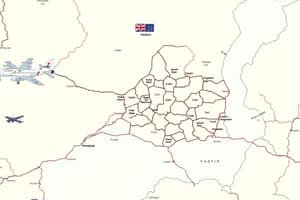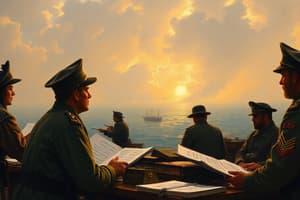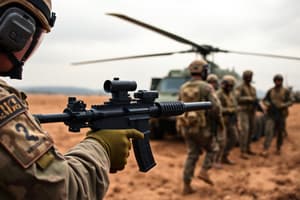Podcast
Questions and Answers
What is the desired outcome of assessing information collection activities?
What is the desired outcome of assessing information collection activities?
- Monitoring mere operational progress
- Reducing the number of collection tasks
- Delivering relevant information to the commander on time (correct)
- Increasing the complexity of operations
A running estimate evaluates the accuracy and relevancy of predictions against actual occurrences.
A running estimate evaluates the accuracy and relevancy of predictions against actual occurrences.
True (A)
What informs the staff of the status of collection on all requirements?
What informs the staff of the status of collection on all requirements?
Running estimate
After each phase of the operation, staffs conduct an ______ to examine which requirements were answered.
After each phase of the operation, staffs conduct an ______ to examine which requirements were answered.
Match the following steps involved in assessing information collection activities:
Match the following steps involved in assessing information collection activities:
What type of tasks are primarily directed towards subordinate units, systems, sensors, and Soldiers?
What type of tasks are primarily directed towards subordinate units, systems, sensors, and Soldiers?
Essential information collection tasks are solely derived from specified tasks.
Essential information collection tasks are solely derived from specified tasks.
What should the staff create to support the information collection requirements?
What should the staff create to support the information collection requirements?
The _____ of collection assets includes aspects like range, technical characteristics, and durability.
The _____ of collection assets includes aspects like range, technical characteristics, and durability.
Which of the following is NOT a factor when evaluating collection assets?
Which of the following is NOT a factor when evaluating collection assets?
The effective range of a collecting asset does not impact its ability to observe target activity.
The effective range of a collecting asset does not impact its ability to observe target activity.
Match the following evaluation criteria with their respective explanations:
Match the following evaluation criteria with their respective explanations:
What is one key consideration for communication requirements from a collection asset?
What is one key consideration for communication requirements from a collection asset?
What drives the information collection activities in military operations?
What drives the information collection activities in military operations?
Information collection activities are only necessary during the initial phase of operations.
Information collection activities are only necessary during the initial phase of operations.
What does synchronization refer to in the context of military operations?
What does synchronization refer to in the context of military operations?
Commanders issue their commander’s intent to drive the operations process and direct __________ activities.
Commanders issue their commander’s intent to drive the operations process and direct __________ activities.
Which of the following is NOT one of the staff functions involved in conducting information collection activities?
Which of the following is NOT one of the staff functions involved in conducting information collection activities?
Match the following stages of information collection with their correct descriptions:
Match the following stages of information collection with their correct descriptions:
Military operations requiring information collection vary in timeframe depending on the type of operation.
Military operations requiring information collection vary in timeframe depending on the type of operation.
What determines the timeframe for gathering information during military operations?
What determines the timeframe for gathering information during military operations?
What is the primary method used by the staff to integrate available resources into a plan?
What is the primary method used by the staff to integrate available resources into a plan?
The analysis during the Course of Action (COA) development process does not influence the recommended tasking of collection assets.
The analysis during the Course of Action (COA) development process does not influence the recommended tasking of collection assets.
What are CCIRs and why are they important during COA development?
What are CCIRs and why are they important during COA development?
During the COA process, the staff assesses __________ to ensure that tasks are being accomplished effectively.
During the COA process, the staff assesses __________ to ensure that tasks are being accomplished effectively.
Match the following terms with their descriptions:
Match the following terms with their descriptions:
What does collaboration between operations and intelligence staffs primarily focus on?
What does collaboration between operations and intelligence staffs primarily focus on?
The orders production process is the initial step in directing units to conduct information collection tasks.
The orders production process is the initial step in directing units to conduct information collection tasks.
What process does the staff utilize to logically move through the war gaming process?
What process does the staff utilize to logically move through the war gaming process?
Which factor affects the sustainability of collection assets?
Which factor affects the sustainability of collection assets?
Vulnerability in collection operations refers only to threat forces in the target area.
Vulnerability in collection operations refers only to threat forces in the target area.
What do staffs evaluate to understand the reliability of collection assets?
What do staffs evaluate to understand the reliability of collection assets?
The collection system must assess its vulnerability to the threat's ability to __________ its assets.
The collection system must assess its vulnerability to the threat's ability to __________ its assets.
Match the collection asset characteristics with their descriptions:
Match the collection asset characteristics with their descriptions:
What role does weather play in collection operations?
What role does weather play in collection operations?
What factors affect the effectiveness of collection sensors during varying light conditions?
What factors affect the effectiveness of collection sensors during varying light conditions?
All collection sensors are capable of operating at night or in limited visibility conditions.
All collection sensors are capable of operating at night or in limited visibility conditions.
The longer the collection period, the easier it is to find assets for continuous activity.
The longer the collection period, the easier it is to find assets for continuous activity.
What must staffs analyze to determine the availability of collection assets?
What must staffs analyze to determine the availability of collection assets?
What is meant by 'geolocation accuracy' in the context of collection assets?
What is meant by 'geolocation accuracy' in the context of collection assets?
The ___ of the collector refers to its ability to withstand challenging environmental conditions.
The ___ of the collector refers to its ability to withstand challenging environmental conditions.
Match the following collection sensor capabilities with their descriptions:
Match the following collection sensor capabilities with their descriptions:
Which statement best describes the impact of urban environments on collection sensors?
Which statement best describes the impact of urban environments on collection sensors?
Collection assets must be able to report collected information regardless of the environmental conditions.
Collection assets must be able to report collected information regardless of the environmental conditions.
What is thermal crossover in relation to collection assets?
What is thermal crossover in relation to collection assets?
Flashcards
Commander's Critical Information Requirements (CCIRs)
Commander's Critical Information Requirements (CCIRs)
The commander's primary information needs that are crucial for successful operations.
Information Collection
Information Collection
The process of gathering, processing, analyzing, and distributing information to support military operations.
Commander's Understanding, Visualization, and Decisionmaking
Commander's Understanding, Visualization, and Decisionmaking
The process of understanding, visualizing, and making decisions about a battlefield based on collected information.
Synchronization
Synchronization
Signup and view all the flashcards
Intelligence Preparation of the Battlefield (IPB)
Intelligence Preparation of the Battlefield (IPB)
Signup and view all the flashcards
Information Collection Cycle
Information Collection Cycle
Signup and view all the flashcards
Staff Functions for Information Collection
Staff Functions for Information Collection
Signup and view all the flashcards
Focusing on Commander's Requirements
Focusing on Commander's Requirements
Signup and view all the flashcards
Specified Information Collection Tasks
Specified Information Collection Tasks
Signup and view all the flashcards
Implied Information Collection Tasks
Implied Information Collection Tasks
Signup and view all the flashcards
Essential Information Collection Tasks
Essential Information Collection Tasks
Signup and view all the flashcards
Reviewing Available Collection Assets
Reviewing Available Collection Assets
Signup and view all the flashcards
Range of Collection Asset
Range of Collection Asset
Signup and view all the flashcards
Day and Night Effectiveness
Day and Night Effectiveness
Signup and view all the flashcards
Reporting Timeliness
Reporting Timeliness
Signup and view all the flashcards
Geolocation Accuracy
Geolocation Accuracy
Signup and view all the flashcards
Seeing through Obscurants
Seeing through Obscurants
Signup and view all the flashcards
Durability
Durability
Signup and view all the flashcards
Environmental Effects
Environmental Effects
Signup and view all the flashcards
Ground Composition Analysis
Ground Composition Analysis
Signup and view all the flashcards
Technical Characteristics
Technical Characteristics
Signup and view all the flashcards
Sustainability in Collection
Sustainability in Collection
Signup and view all the flashcards
Vulnerability in Collection
Vulnerability in Collection
Signup and view all the flashcards
Performance History in Collection
Performance History in Collection
Signup and view all the flashcards
Asset Availability in Collection
Asset Availability in Collection
Signup and view all the flashcards
Terrain Transversability in Collection
Terrain Transversability in Collection
Signup and view all the flashcards
Threat Activity in Collection
Threat Activity in Collection
Signup and view all the flashcards
Collection System Capability
Collection System Capability
Signup and view all the flashcards
Vulnerability to Deception
Vulnerability to Deception
Signup and view all the flashcards
Information Collection Planning
Information Collection Planning
Signup and view all the flashcards
Asset Assessment
Asset Assessment
Signup and view all the flashcards
CCIR Refinement
CCIR Refinement
Signup and view all the flashcards
War Gaming for Information Collection
War Gaming for Information Collection
Signup and view all the flashcards
Orders Production
Orders Production
Signup and view all the flashcards
Information Collection Assessment
Information Collection Assessment
Signup and view all the flashcards
Information Collection Integration
Information Collection Integration
Signup and view all the flashcards
Asset Mix and Redundancy
Asset Mix and Redundancy
Signup and view all the flashcards
Why Assess Information Collection?
Why Assess Information Collection?
Signup and view all the flashcards
Monitoring and Reporting
Monitoring and Reporting
Signup and view all the flashcards
Running Estimate
Running Estimate
Signup and view all the flashcards
Audit Trail
Audit Trail
Signup and view all the flashcards
Post-Operation Assessment
Post-Operation Assessment
Signup and view all the flashcards
Study Notes
Information Collection Planning and Assessment
- Commanders direct information collection by approving critical information requirements (CCIRs) and driving the operations process.
- Information collection success depends on aiding commander understanding, visualization, and decision-making.
- Operations and information collection are interdependent. Commanders guide these activities through intent and approved CCIRs.
- Information collection is continuous throughout the operation.
- Commanders and staffs synchronize warfighting functions for mission accomplishment. Information collection activities are part of this synchronization, including intelligence preparation of the battlefield (IPB).
- Synchronization is arranging military actions for maximum relative combat power.
- Information collection planning is an ongoing cycle (planning, preparing, executing, assessing). Timeframes depend on echelon, assets, and operation type.
- Information collection activities include functions like planning, collection, processing, exploitation, analysis, dissemination, integration, evaluation, and feedback.
- Plans should connect to the overall operations plan. Collection assets are coordinated to answer commander requirements.
- Information collection synchronizes assets to provide intelligence for course of action (COA) selection and targeting.
- The intelligence staff ensures all available collection assets provide needed information.
- Plans are based on initial threat assessments, and updated as needed.
- Synchronized plans support the scheme of maneuver.
- Information collection planning begins with IPB (threat characteristics, enemy templates, enemy COA statements, and event template)
- The final step is well-defined CCIRs and collection strategies.
Personnel Recovery Support
- Personnel recovery support focuses on collecting information to recover personnel isolated, missing, detained, or captured.
- Support includes detailed analysis, products, and defense support of civil authorities.
Military Decision-Making Process (MDMP) and Information Collection Planning
- Information collection planning is integral to MDMP, beginning with the mission receipt (e.g., warning order).
- Information collection directly supports intelligence and operations products used during MDMP.
- Information collection activities are continuous, cooperative, and interactive.
- Intelligence and operations staffs collaborate in developing information collection products.
- Information collection planning inputs and outputs during MDMP are detailed.
- Commanders and staff shifts efforts to describing the operational environment using mission variables (receipt of mission).
- Commanders provide initial guidance to staff.
- Staff uses this to develop initial information collection tasks (first warning order).
- Critical information is identified in commander's guidance.
Mission Analysis
- Staff analyses higher headquarters orders to extract information collection tasks and constraints.
- Analyzing orders includes limits of reconnaissance, availability of assets from higher echelons, and asset allocation.
- Intelligence preparation of the battlefield (IPB) is crucial for effective information collection planning.
- IPB products include threat characteristics, terrain overlays, weather effects, enemy templates, COA statements, enemy templates, and high-payoff target lists.
- These products help identify information gaps and guide threat and terrain considerations.
- The staff uses geospatial information to develop line-of-sight products regarding terrain.
Determining Specified, Implied, and Essential Tasks
- Staff identifies specified, implied, and essential information collection tasks.
- Specified tasks target units, systems, sensors, and soldiers. Implied tasks detail system/sensor initialization.
- Essential tasks are derived from specified and implied tasks.
Review Available Assets
- Staff reviews all available assets, creating an inventory of capabilities.
- Inventory based on higher HQ orders, assets under operational control, and assets from higher echelons.
- Assets evaluated based on range, day/night effectiveness, technical characteristics, reporting timeliness, geolocation accuracy, and durability.
- Staff considers operational conditions (weather, terrain, adversary activity) and availability of assets.
Reporting Timelines, Geolocation, and Durability
- Reporting timeliness reviews time required to convert data for reporting.
- Geolocation accuracy considers ability to determine exact locations (important for targeting).
- Durability assesses stability and endurance of collection assets.
Threat Activity, Sustainability, Vulnerability
- Threat activity considers how much activity the collector identifies.
- Sustainability addresses a collector's resource use over time.
- Vulnerability assesses a collector's susceptibility to threats (e.g., location, denial/deception).
Determining initial CCIRs and EEFI
- Determining initial critical information requirements (CCIRs) and essential elements of friendly information (EEFI) is crucial.
- EEFI/CCIRs refined from initial analysis of available intelligence, IPB, and unit/HQ requirements.
- Staff recommends requirements to the commander for approval.
Developing the Initial Information Collection Plan
- Initial information collection plan is generated from commanders' guidance, intelligence gaps, and enemy situation templates.
- The initial plan should be generic, adaptable to COA development.
Requests for Information and Requests for Support
- Information requests to higher or lateral echelons seek information beyond organic assets.
- Requests are tracked and prioritized.
- Feedback to higher headquarters needed to indicate if the requirement can be fulfilled.
Develop and Synchronize Production Requirements
- Intelligence staffs ensure timely and relevant intelligence products to commanders and staffs.
- Using analytical and production efforts, staffs answer CCIRs and provide situational understanding.
Course of Action Development
- Staff uses IPB and enemy situation templates to integrate information collection considerations in COA development.
- Staffs create information collection tasks to support each COA.
- This step works to identify collection assets, terrain, and enemy scenarios.
Orders Production, Dissemination, and Transition
- Staff transforms the selected COA into operations concepts and supporting information.
- This produces operational orders.
- Orders detail needed information for subordinate units.
Information Collection Assessment
- Assessment focuses on monitoring and evaluating information collection progress.
- Staffs monitor reports, and track how collection assets meet tasks.
- A running estimate is used to assess accuracy and timeliness.
- Post-operational assessments examine the collection plan's effectiveness.
Studying That Suits You
Use AI to generate personalized quizzes and flashcards to suit your learning preferences.



